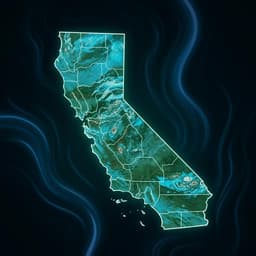
Earth Sciences
The conterminous United States are projected to become more prone to flash floods in a high-end emissions scenario
Z. Li, S. Gao, et al.
In a groundbreaking study, researchers, including Zhi Li and Shang Gao, reveal that flash floods in the US are set to become more frequent and intense due to the impacts of climate change. Utilizing high-resolution climate simulations, they predict a significant increase in flashiness, especially in the Southwest and central regions, highlighting an urgent need for resilient mitigation measures.
~3 min • Beginner • English
Introduction
The study investigates how flash flood characteristics across the conterminous United States (CONUS) may change under future warming, addressing the central question of how floods will evolve in a changing climate. Flash floods, driven by intense convective precipitation, cause substantial economic losses and fatalities. While theory and observations indicate intensifying short-duration precipitation with warming, coarse-resolution global climate models struggle to resolve mesoscale convective processes critical for flash flooding. Leveraging convection-permitting climate simulations, the authors aim to quantify future changes in flood flashiness, frequency, and geographic hotspots, providing actionable insights for risk management and early warning.
Literature Review
Prior work shows strong links between warming and intensification of short-duration rainfall extremes, with potential increases exceeding Clausius-Clapeyron rates due to storm dynamics and structure. Conventional GCMs inadequately resolve mesoscale convection, limiting flood-relevant insights; convection-permitting models (kilometer-scale) better simulate sub-daily extremes. Studies have examined changes in hurricanes, atmospheric rivers, snowmelt, and extreme precipitation using such models. However, streamflow responses to changing precipitation extremes remain debated, with some studies emphasizing antecedent catchment conditions and observing decreasing trends in certain flood frequencies. The paper situates itself within this context, using high-resolution simulations and an operational hydrologic model to assess flashiness and flood-producing storm changes across climatic regions.
Methodology
Climate forcing: Two convection-permitting Weather Research and Forecasting (WRF v3.4.1) simulations at 4-km horizontal and hourly temporal resolution are analyzed over the CONUS and parts of Canada/Mexico. The retrospective control (CTL) downscales ERA-Interim (Oct 2000–Sep 2013) with spectral nudging. The future pseudo-global-warming (PGW) run applies thermodynamic perturbations (horizontal wind, geopotential heights, temperature, specific humidity, SST, soil temperature, sea level pressure, sea ice) derived from the ensemble mean of 19 CMIP5 models for 2070–2100 relative to 1976–2005 under RCP8.5, added to ERA-Interim boundaries. PGW preserves synoptic patterns via nudging while isolating thermodynamic change signals.
Hydrologic modeling: The Ensemble Framework For Flash Flood Forecasting (EF5) with CREST v2.1 rainfall-runoff and kinematic wave routing is used to simulate streamflow at 1-km resolution, hourly timestep, for 2001–2011 (11 full years). WRF precipitation at 4 km is downscaled to 1 km by nearest neighbor. Distributed parameters match operational EF5 runs. A parallel EF5 run with Stage IV precipitation (2001–2011) is used to separate forcing vs model errors. The model is suited for heavy-rainfall-induced flash floods rather than snowmelt.
Event identification and association: At each HUC8 basin, hydrograph separation (storm flow vs baseflow) uses the filtered revised constant k method. Flood events are identified when (1) peak streamflow exceeds the 2-year flood threshold (bankfull) computed by fitting annual maxima with a log-Pearson Type III distribution; and (2) the rising slope (peak flow divided by rise time) exceeds an area-dependent threshold (following Chow et al.), ensuring focus on flashier events. Rainfall events are linked to flood events using the Characteristic Point Method (CPM), associating separated stormflow events with rainfall within a search window.
Flashiness index: For each event, Flashiness = (Qp − Qbase)/(A · Tr), where Qp is peak flow, Qbase is baseflow at peak, A is drainage area, and Tr is flood rise time. Event flashiness values are scaled to [0,1] via empirical CDF. Basin-level flashiness is the median of event flashiness values. Flashiness and rainfall/flow characteristics include rainfall duration (Dr), peak rate (Rp), volume (Vr), flood duration (Df), peak flow (Qp), volume (Vf), and rainfall-flood peak lag (Lag).
Aggregation and regions: Results are aggregated to 17 Bukovsky climate regions to interpret regional differences. Analyses consider frequency changes, distributions of rainfall/flow metrics, and fractional increases/decreases per region.
Validation: CTL precipitation evaluated against NCEP Stage IV shows correlation >0.6 (Supplementary). Hydrologic outputs validated against the Global Streamflow Characteristics Dataset (quantiles 90/95/99) indicate reasonable performance. Known biases include CTL precipitation underestimation >10% vs Stage IV in some regions and propagated runoff bias (~8%), partially offset by model parameters.
Data and code: Climate simulations from NCAR RDA ds612.0; EF5/CREST available via GitHub/Zenodo; CPM MATLAB code publicly accessible.
Key Findings
- CONUS-wide flashiness increase: Future floods are 7.9% flashier on average by century’s end under RCP8.5-like thermodynamic changes (PGW), implying steeper rising limbs and higher peaks with reduced lead time.
- Regional flashiness changes: The Southwest exhibits the largest increase among existing hotspots (+10.5%); central US emerges as a new hotspot with about +8.5 to +8.6% increase; positive flashiness changes advance northward into the Northern Rockies, Northern Plains, and Prairie.
- Frequency of flood events: Intermittent-regime basins (Southwest, Great Plains, Prairie) show marked increases in flood occurrences in PGW. Small-to-medium basins display wide frequency change ranges (−50% to +350%), while large basins are more stable due to modulation by antecedent wetness.
- Extreme precipitation in flood-producing events increases heterogeneously: Rockies and Appalachia–Atlantic regions show significant increases (mean +34.5% and +24.7%; 99th percentile +28.5% and +21.9%, respectively). Eastern US mean extreme precipitation increase of ~26.6% corresponds to ~104% more frequent floods. The Southwest shows the largest change (mean +40.4%; 99th +51.1%), translating to ~+123% flood frequency. Pacific Southwest/Northwest and Mezquital are relatively insensitive, with smaller or insignificant changes and an overall ~+67.1% flood frequency increase across these regions; Mezquital shows decreases in mean and extreme precipitation.
- Event characteristics shift: Rainfall and flood durations (Dr, Df) generally decrease across CONUS. Regions with above-normal fractions of negative duration changes include Southern Plains (Dr 55.8%, Df 56.7%), Deep South (54.1%, 59.9%), and Southeast (56.6%, 59.1%) versus CONUS baselines (~52%). Peak rainfall and peak flow (Rp, Qp) increase predominantly in western regions (e.g., Pacific NW: increases in 83.2% and 80.6% of events). Rainfall and flood volumes (Vr, Vf) also increase in these regions.
- Lag time reduction: Rainfall–flood peak lag decreases by ~7.5% on average, with larger fractions of reduced lag in humid eastern regions (65.1%) than arid regions (60.3%), indicating flashier hydrographs.
- Spatial extent: 87.4% of HUC8 basins show increased flashiness in PGW. Outside NAM-impacted Arizona, hotspots exhibit moderate increases (~+4.1%), with scaling rates near zero, suggesting geomorphologic/land cover constraints.
- Scaling with rainfall extremes: Flashiness correlates weakly with duration but positively with peak rates and volumes; roughly a 100% increase in extreme rainfall corresponds to ~10% increase in flashiness, with a plateau beyond ~120% reflecting physical conveyance limits.
Discussion
The study demonstrates that thermodynamic warming signals, resolved by convection-permitting simulations and translated through an operational hydrologic model, lead to systematically flashier floods across most US basins. This addresses the central question by quantifying both magnitude and geography of future flash flood changes, including emerging hotspots in the central US and a northward shift of risk. Shorter rainfall/flood durations, higher peaks, and reduced lag times combine to reduce warning lead time, emphasizing operational and infrastructure implications.
Findings align with literature on intensifying short-duration precipitation and decreasing event durations but differ from some studies on flood magnitude trends due to methodological choices: use of a high-end RCP8.5 thermodynamic perturbation (PGW), convection-permitting resolution (4 km) resolving convective processes, and event-based flashiness focus rather than annual maxima alone. Results suggest that where antecedent wetness and basin properties dominate, flood responses can differ, explaining regional variability. Overall, the study underscores the need for climate-resilient flood management, especially in regions historically less prone to flash floods that are projected to become hotspots.
Conclusion
The paper concludes that: (1) Flood flashiness increases by 7.9% across CONUS, implying faster-onset, higher-peak floods and reduced early warning opportunities; (2) Outside NAM regions, hotspots experience moderate increases (~+4.1%), while the Southwest becomes much flashier (+10.5%); (3) The central US experiences substantial increases (~+8.5 to +8.6%) with the Deep South and Prairie transitioning into new flash flood hotspots; (4) Flash flood risks advance northward, challenging local resilience. These findings call for reassessment of flood design standards and implementation of climate-resilient mitigation and adaptation, with attention to emerging hotspots and potential compounding effects from urbanization and infrastructure constraints. Future research should examine seasonality, storm–flood spatial extents, and broader anthropogenic influences (e.g., river controls, land use change).
Limitations
- Scenario and modeling framework: The PGW approach isolates thermodynamic changes under a high-end RCP8.5 scenario and does not capture potential changes in large-scale circulation patterns; actual future emissions and dynamics may differ.
- Anthropogenic factors excluded: Land use/land cover change, urbanization, and river regulation are not modeled; these could amplify runoff and flashiness (e.g., reduced infiltration, urban heat island effects on convection).
- Forcing and model biases: CTL precipitation shows >10% underestimation relative to Stage IV in some regions; propagated runoff bias (~8%) exists, though partially offset by hydrologic parameters. Stage IV coverage limitations (especially on the West Coast) constrain evaluation regions.
- Process coverage: EF5/CREST setup focuses on rainfall-driven flash floods and is not designed for snowmelt or rain-on-snow processes; some flood-generating mechanisms may be underrepresented.
- Metric scope: Rainfall indices analyzed emphasize rates, volumes, time-to-peak, and duration; other potentially informative metrics (e.g., ratios of peak rates to volumes) were not explored.
Related Publications
Explore these studies to deepen your understanding of the subject.







